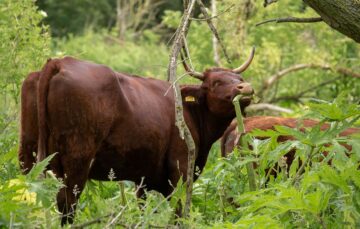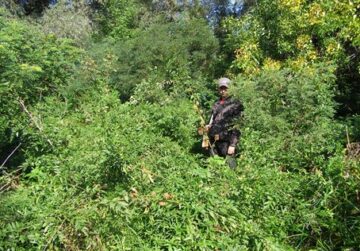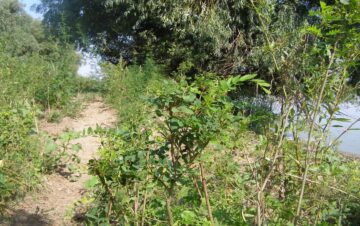Invasive alien plant species form a serious challenge in many areas across Europe, where their rapid spread can severely impact ecosystems. A natural solution may be present in the form of (natural) grazing, where herbivores can suppress or even eliminate the proliferation of invasive species. In this blog, we look in more detail at the case of Amorpha fruticosa, or false indigo-bush, which causes major problems, particularly in the Danube basin, and for which extensive grazing can offer a solution.


A cheap solution?
One of the least known aspects of herbivory is its influence on the occurrence of invasive plant species. A serious problem in various European regions, where native flora and fauna are outcompeted by species that are not native to the area. Measures to control these invasive alien species often take place with relatively expensive, mechanical interventions, with varying results. As some of these invasive species have colonized abandoned grasslands, this raises the question of whether the comeback of (more natural) grazing could play a role in reversing the process and eradicating these invasive species in favour of more diverse, natural ecosystems.
First hopeful signs

For many invasive alien plant species, the effects of extensive grazing on their growth and abundance are still unknown. But for others, it becomes increasingly evident that grazing could play an important role in their control.
One example is the suppression of American black cherry (Prunus serotina) by European bison or by (high densities of) goat and cattle. Also, giant balsam (Impatiens glandulifera) and giant hogweed (Heracleum mantegazzianum) make up part of the diet of large herbivores in some areas and can be significantly suppressed through grazing. The latter species is very palatable to cattle and even appears to be a preferred part of the diet of free-roaming cattle in the rewilded floodplains in the Netherlands. There are other species, however, like the Canadian goldenrod (Solidago canadensis) that are avoided by these grazers and will spread further, if no additional measures are taken.
The Amorpha case

One of the case study areas within GrazeLIFE is the Danube Delta. Here, the invasive false indigo-bush (Amorpha fruticosa) has widely dispersed along the Danube. This species, originally American, has spread over thousands of hectares, especially in the catchment area of the Danube and its tributaries like the Sava, Drava and Tisza rivers, with a major levelling influence on the indigenous flora and fauna.
In the Danube Delta, Amorpha grows in narrow belts on riverine bars. In places where there is no grazing, the species forms monotonous thickets which make natural regeneration of indigenous tree species impossible under their three to four metre-high canopy.
Efforts are underway across the Danube basin to combat this aggressive shrub species and here grazing appears to be an important part of a successful approach. In the Sava floodplains, the NGO BED (Ecological Society of Brod) has proven that the combination of cattle grazing and treading (by Podolian cattle) is the only permanent way to keep Amorpha under control on a large scale and enable the original flora and fauna to regenerate.
A significant role for cattle

Another example can be found on Ermakov Island, where the plant has spread after agricultural abandonment. However, the reintroduction of horses and water buffalo on the island has seen the animals start to eat and trample Amorpha, especially in the winter. They inflict a lot of damage on the shrubs, giving a diverse range of indigenous vegetation more space to flourish.
Further upstream, on the island of Tataru, a herd of Ukrainian grey cattle suppresses Amorpha to the extent that this invasive species doesn’t have a chance to dominate the vegetation. Research on Tataru Island has shown the significant role of cattle in opening up the dense thickets of smaller willow species (Salix triandra and Salix fragilis), as well as suppressing the Amorpha fruticosa and opening up its groves.
Introduced in 2008, grey cattle had almost doubled the coverage of meadows on Tataru Island by 2010.
Concluding remarks
Natural grazing is not a panacea for all invasive species. But it appears that in many cases it can significantly suppress them and allow more complex native ecosystems to develop.
As such, extensive grazing systems should be supported as a relatively inexpensive way of tackling invasive species, particularly in regions strongly impacted by one specific species (for example, the false indigo-bush in the Danube basin and giant hogweed in some other areas).
Misha Nesterenko and Oleg Dyakov/Rewilding Ukraine
Wouter Helmer/Rewilding Europe